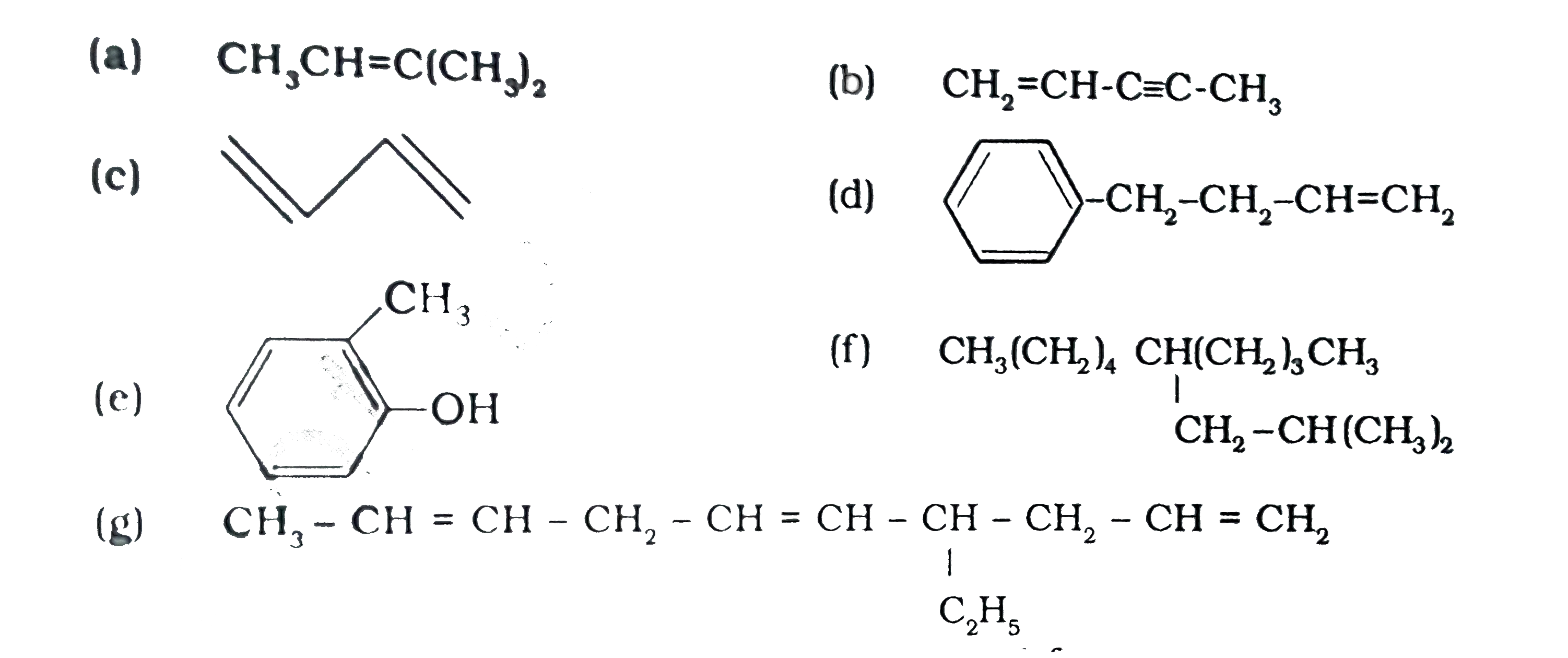Predict the major product of the acid catalysed dehydration of the following alcohols :
(a)(CH3)2C(OH)CH2CH3 , (b)CH3CH2CH2CH(OH)CH3
(c )(CH3)2C(OH)CH(CH3)2 , (iv)(CH3)3CCH2OH
The correct Answer is:(a)CH3−CH3∣C=CHCH3
(b)CH3−CH2−CH=CH−CH3
(c)(##RESCHMORMIVE01003_A01##)
(d)CH3−CH3∣C=CHCH3
To predict the major product of the acid-catalyzed dehydration of the given alcohols, we will follow a systematic approach. The dehydration of alcohols involves the formation of alkenes through the elimination of a water molecule, typically under acidic conditions. The major product is usually the more substituted alkene due to stability reasons (Zaitsev's rule).
1. Identify the structure: The alcohol can be represented as:
CH3|C(OH)|CH2∣CH3
2. Protonation of the hydroxyl group: In the presence of acid, the hydroxyl group (OH) is protonated to form a better leaving group (water).
3. Formation of carbocation: The protonation leads to the formation of a carbocation. The carbocation can be formed at the carbon where the OH group was attached.
4. Elimination of water: Two elimination pathways are possible:
- Elimination of a hydrogen from the adjacent CH2 group leads to:
CH3|C+|CH2∣CH3
- Elimination of a hydrogen from the other CH3 group leads to:
CH2|C+|CH3∣CH3
5. Determine the major product: The more stable product is the one formed by the elimination from the CH3 group, leading to:
CH3|C=CH2|CH3
This is the major product (more substituted alkene).
(b) For CH3CH2CH2CH(OH)CH3:
1. Identify the structure: The alcohol can be represented as:
CH3|CH2|CH2∣C(OH)
2. Protonation of the hydroxyl group: The hydroxyl group is protonated.
3. Formation of carbocation: The carbocation is formed at the carbon where the OH group was attached.
4. Elimination of water: The elimination can occur from either side:
- Elimination from the CH3 side leads to:
CH3|CH2|C+∣CH2
- Elimination from the CH2 side leads to:
CH3|CH2|CH2∣C+
5. Determine the major product: The more substituted product is formed by elimination from the CH2 group, leading to:
CH3|CH2|C=CH2
This is the major product.
(c) For (CH3)2C(OH)CH(CH3)2:
1. Identify the structure: The alcohol can be represented as:
CH3|C(OH)|CH∣CH3
2. Protonation of the hydroxyl group: The hydroxyl group is protonated.
3. Formation of carbocation: The carbocation is formed at the carbon where the OH group was attached.
4. Elimination of water: The elimination can occur from either side:
- Elimination from the CH3 group leads to:
CH3|C+|CH(CH3)
- Elimination from the adjacent CH group leads to:
CH3|C+|CH3
5. Determine the major product: The more substituted product is formed by elimination from the CH group, leading to:
CH3|C=CH2|CH3
This is the major product.
(iv) For (CH3)3CH2OH:
1. Identify the structure: The alcohol can be represented as:
CH3|C(OH)|CH2
2. Protonation of the hydroxyl group: The hydroxyl group is protonated.
3. Formation of carbocation: The carbocation is formed at the carbon where the OH group was attached.
4. No beta-hydrogens: In this case, the carbon bearing the OH does not have any beta-hydrogens available for elimination.
5. Rearrangement: A rearrangement occurs where a methyl group shifts to form a more stable carbocation:
CH3|C+|CH3
6. Elimination of water: The elimination leads to:
CH3|C=CH2|CH3
This is the major product.
Summary of Major Products:
- (a) Major product: More substituted alkene from (CH3)2C(OH)CH2CH3 is C=CH(CH3).
- (b) Major product: More substituted alkene from CH3CH2CH2CH(OH)CH3 is C=CH(CH3).
- (c) Major product: More substituted alkene from (CH3)2C(OH)CH(CH3)2 is C=CH(CH3).
- (iv) Major product: Rearranged alkene from (CH3)3CH2OH is C=CH(CH3).
CH3|C(OH)|CH2∣CH3
- Elimination of a hydrogen from the adjacent CH2 group leads to:
CH3|C+|CH2∣CH3
- Elimination of a hydrogen from the other CH3 group leads to:
CH2|C+|CH3∣CH3
CH3|C=CH2|CH3
This is the major product (more substituted alkene).
CH3|CH2|CH2∣C(OH)
- Elimination from the CH3 side leads to:
CH3|CH2|C+∣CH2
- Elimination from the CH2 side leads to:
CH3|CH2|CH2∣C+
CH3|CH2|C=CH2
This is the major product.
CH3|C(OH)|CH∣CH3
- Elimination from the CH3 group leads to:
CH3|C+|CH(CH3)
- Elimination from the adjacent CH group leads to:
CH3|C+|CH3
CH3|C=CH2|CH3
This is the major product.
CH3|C(OH)|CH2
CH3|C+|CH3
CH3|C=CH2|CH3
This is the major product.
- (a) Major product: More substituted alkene from (CH3)2C(OH)CH2CH3 is C=CH(CH3).
- (b) Major product: More substituted alkene from CH3CH2CH2CH(OH)CH3 is C=CH(CH3).
- (c) Major product: More substituted alkene from (CH3)2C(OH)CH(CH3)2 is C=CH(CH3).
- (iv) Major product: Rearranged alkene from (CH3)3CH2OH is C=CH(CH3).
Topper's Solved these Questions
- BOOK - RESONANCE ENGLISHCHAPTER - ORGANIC REACTION MECHANISMS-IVEXERCISE - Exercise-1 Part-220videos
ORGANIC REACTION MECHANISMS-IV
- BOOK - RESONANCE ENGLISHCHAPTER - ORGANIC REACTION MECHANISMS-IVEXERCISE - Exercise-1 Part-32videos
ORGANIC REACTION MECHANISMS-IV
- BOOK - RESONANCE ENGLISHCHAPTER - ORGANIC REACTION MECHANISMS - IIEXERCISE - APSP Part - 322videos
ORGANIC REACTION MECHANISMS - II
- BOOK - RESONANCE ENGLISHCHAPTER - PERIODIC TABLE & PERIODICITYEXERCISE - ORGANIC CHEMISTRY(BASIC CONCEPTS)27videos
PERIODIC TABLE & PERIODICITY
Similar Questions
Knowledge Check
- Question 1 - Select One
Which is the most suitable reagent among the following distinguish compound (3) from the others ?
(1) CH3C≡C−CH3
(2) CH3CH2−CH2−CH3
(3) CH3CH2C≡CH
(4)CH3CH=CH2ABromine in carbon tetrachlorideBBromine in acetic acid solutionCAlk. KMnO4DAmmonical silver nitrate
Arrange the compounds A to D which have roughly the same molecular weight in order of decreasing boiling points.
(A) CH3CH2CH(OH)CH2CH2CH3
(B) CH3(CH2)5CH3
(C ) CH3CH2C(OH)(CH3)2
(D) CH3(CH2)5OHView SolutionWrite IUPAC names of the following compounds : (a) CH3CH=C(CH3)2
(b) CH2=CH−C≡C−CH3
(c )
(d)
(e )
CH3(CH2)4CH(CH2)3CH3 ∣ CH2−CH(CH3)2View SolutionArrange the following compounds in the increasing order of their boiling points:
CH3CH2CH2CHO,CH3CH2CH2CH2OH,H5C2−O−C2H5,CH3CH2CH2CH3View SolutionGive the IUPAC names of the following alcohols :
CH3(CH2)3−CH∣OH−CH(CH3)2View SolutionHow many will undergo haloform reaction among the following ?
CH3COCH3, CH3CH(OH)CH3, CH3OH, C2H5OH
CH3CH2CH2OHView SolutionGive the IUPAC name of the compound
CH3−CH2−CH(OH)−CH2−CH2−CH(CH3)−CH2−CH3View SolutionGive IUPAC name for each of the following
OH |(CH3)3C−C−CH2CH2CH2CH3 | CH2−CH−CH2−CH3 | OHView Solution

